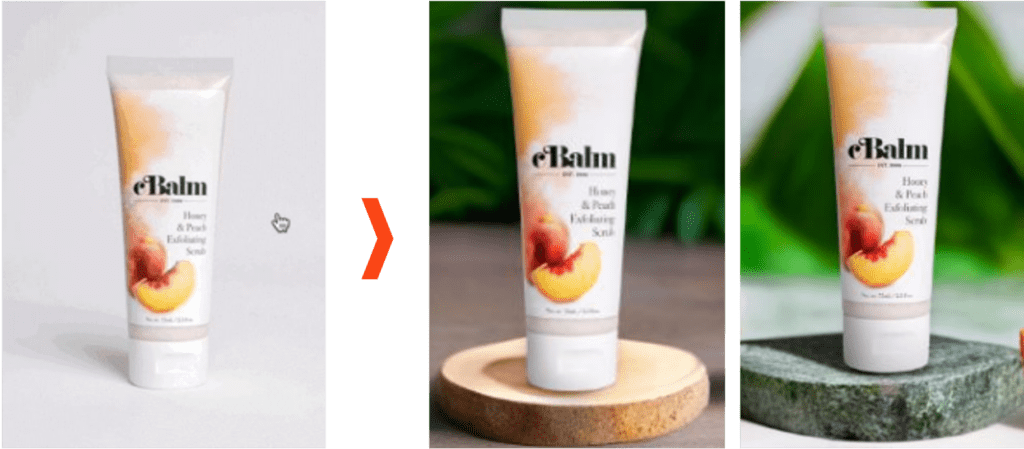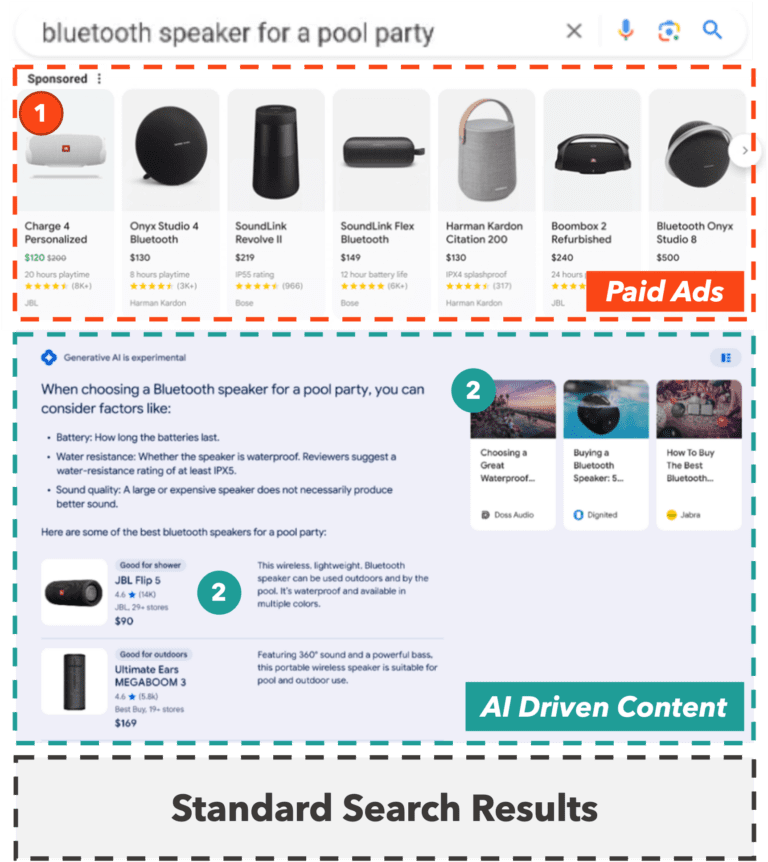As marketers face business and growth challenges, Google addressed these concerns with their latest ad innovations and technological advancements at Google Marketing Live. Ovative took the main stage with Coach to discuss the topic on every marketer’s mind: AI. In addition to AI integrations, Google detailed their creative innovations, enhancements for their campaign consolidation tool PMAX, and introductions to 20+ product announcements. Here are the top four learnings marketers should know from Google Marketing Live and how to leverage these exciting opportunities.
Google Means Business When It Comes To AI
“AI is going to supercharge your ability to keep up with the speed, demands, and unpredictability of consumers like never before.” – Philipp Schindler, Senior Vice President, Chief Business Officer, Google
Google started the event by illustrating how they are putting AI to work for marketers. They are rolling out updates that utilize AI from ad creative to search results. New tools like Google Product Studio allow users to generate creative using AI prompts to review before sending it live. This free tool can help marketers generate scenes, increase image resolution, and edit the backgrounds of ad creative. Additionally, Google can build creative copy that is generated live in the SERP to match users’ searches.

Google is also rolling out a new search experience that brings AI-generated content to the forefront. The new Google experience will display AI-generated responses to search queries above standard search listings. All AI content will be clearly labeled with “Generative AI is experimental.” Google will cite the websites it used to generate the answer and those sites can be clicked on to dig deeper. In contrast to ChatGPT, Google’s primary goal is to drive traffic to websites. Google has not invited the public to try the new AI search but will start inviting users who sign up for the waitlist in the coming weeks.

What Marketers Should Do Next:
As with many industries, AI promises exciting possibilities for improved efficiency and customization. Our experts anticipate that Google will continue to test incorporating ads within the new AI-driven content.
Ovative’s time-tested approach is to always measure first. We suggest testing dynamic AI creative via Beta on smaller segments to gather insights around this new functionality. In these tests, Ovative experts suggest developing new creative variations within brand guidelines that can be approved pre-launch.
Google Is Improving Performance Max, But We’d Like to See Even More Enhancement
Google continues to roll out goal-based campaigns that focus on achieving performance objectives with AI and machine learning. Customer-type goals, custom experiments, and creative enhancements are all coming out of Google Marketing Live. Audience targeting capabilities for high-value new customers and lapsed users are coming soon, as well.
Since the release of Performance Max (PMAX), marketers have lost significant insights into deeper query-level performance. A focus area for Ovative has been the deeper performance insights Google is starting to bring back. Google has added historical data, custom ranges, and transparency to all categories within search term insights.
- Pair PMAX with search campaigns for your top queries in the same account to ensure prioritization for top search keywords. We will now have cleaner views of brand and non-brand queries to validate performance trends. This also presents an opportunity to identify how users are searching for your top products which can be used to inform more specific creative and feed optimizations.
- Asset-level insights have also been enhanced as asset reporting had previously only provided relative ratings of creative assets. Now, PMAX is providing more data to extract richer insights into creative asset performance.
- Rotate out bottom-performing creative and compare these new performance insights with other social channels for cross-channel learning.
- Prior to Google Marketing Live, RSA category insights were restricted to asset-level ad strength. Now, Google is updating reporting to allow visibility into the top-performing categories at the RSA level.
- Identify new themes for additional creative assets and potential ad group segmentation.
While Ovative is excited about the new features Google has unlocked, as Premier Partners our experts are providing them with feedback about how they can improve transparency to drive enterprise results for our clients. After utilizing PMAX campaigns with our clients, our team would like to see the following improvements:
- Network-level reporting to justify spend trends
- Demo-level conversion value rules to inform bidding
- Category-level conversion value rules to inform bidding in consolidated campaigns
- Reporting data transparency to unlock additional insights
- Additional optimization levers to better action on reporting insights
What Marketers Should Do Next:
With the rollout of these new features comes exciting new possibilities for marketers. Ovative experts suggest utilizing the new targeting options to find the most valuable customers and engage recent users. Additionally, we recommend leveraging reporting updates to identify areas of inefficiency and scale opportunity. But, measurement with AI campaigns such as PMAX should never be set it and forget it. Lean on our measurement experts to identify the best approach to measuring AI advertising campaigns effectively.
First-Party Data is Still the Priority
As cookie deprecation is still a looming threat, Google is doubling down on its first-party data approach. They are rolling out more audience-based conversion rules to prioritize bidding for high-value new customers and lapsed users.
Customer Acquisition Goals allow marketers to optimize for new customers, in addition to maximizing sales. This can be accomplished through three different modes:
- Bid Only to New Customers.
- Bid Higher for New Customers than Existing ones
- Bid Higher for High-Value Customers (now in beta!)
Re-engagement Goals will enable marketers to re-engage lapsed or disengaged customers powered by AI and first-party data.
What Marketers Should Do Next:
Ovative works to improve marketing performance by focusing on Future Customer Value, one of the main pillars of our holistic metric Enterprise Marketing Return (EMR). Our experts believe that Customer Acquisition Goals and Re-engagement Goals are exciting new levers to optimize EMR and improve your customer file. Here are some steps marketers should take to leverage these new capabilities:
- Ensure that CRM lists are updated frequently and segment lists by customer type (e.g. lapsed)
- Reach out to Ovative to learn more about participating in the High-Value Customers Beta
- Test Re-engagement Goals to bid more aggressively against existing lapsed users to re-engage them
Google Campaign Consolidation Continues
Google continues to streamline its campaign experience for marketers, providing fewer options with more capabilities within each. Like many other platforms, Google is emphasizing video assets and incorporating YouTube placements in their new campaign types.
- Video View campaigns are new campaigns that are focused on maximizing video views across skippable in-stream ads, in-feed ads, and Shorts.
- Demand Gen campaigns combine Discovery image-based ads, YouTube Instream and YouTube Shorts. They will leverage AI to engage with consumers and drive action. Marketers will also be able to create lookalike segments based on “seed lists.”
What Marketers Should Do Next:
As marketers begin to explore these new consolidated offerings, it’s important to incorporate them into their testing roadmaps to understand the impact. Ovative experts suggest testing and comparing the new Video View campaigns to the performance of skippable CPV campaigns. For Demand Gen campaigns, test based on a specific audience you’re looking to reach as this campaign can help grow demand for traditional lower funnel search.
These campaigns can be a great addition to upcoming holiday campaigns. To use these campaigns during the holiday season, Ovative experts suggest prioritizing video creation with strong calls to action in both horizontal and vertical formats for Video View campaigns. For Demand Gen campaigns, use conversion value rules to prioritize bidding on audience, geo, and device segments.
So, What’s Next?
Google’s offerings constantly evolve, and staying ahead of the curve can be difficult. We expect Google to continue to leverage AI and machine learning to optimize performance in real-time. It will be vital to layer additional signals (e.g. Store sales, key site actions) and customer insights (e.g. new/lapsed) to drive enterprise impact.
Let us help you explore your options with Google and optimize your media mix. Connect with us to ensure your marketing is reaching its full potential!
